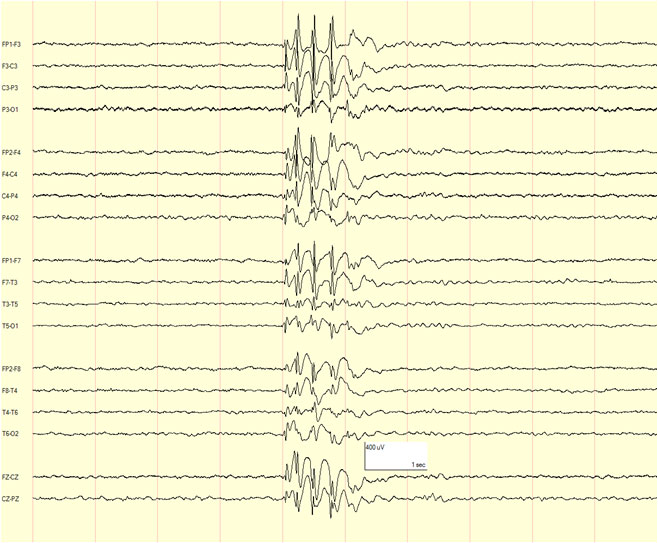

- Overview
- Log In For Videos
- Give Feedback
- Seizure Classification
- Unknown Onset Seizure
- Neonatal Seizure
- Epilepsy Classification
- Generalized Epilepsy
- Focal Epilepsy
- Generalized and Focal Epilepsy
- Unknown Epilepsy
- Epilepsy Syndromes
- Epilepsy Etiologies
- Metabolic Etiologies
- Immune Etiologies
- Infectious Etiologies
- Unknown Etiologies
- Encephalopathy
- Epilepsy imitators
JUVENILE ABSENCE EPILEPSY (JAE)
Background
The background is normal. Occipital intermittent rhythmic delta activity (OIRDA) may be seen.
CAUTION Generalized slowing is not seen.
CAUTION Focal slowing
consistently over one area  consider structural brain abnormality.
consider structural brain abnormality.
Interictal
There may be generalized spike-wave, fragments of generalized spike-wave or polyspike-wave.
CAUTION Although focal
spikes can occur, if they consistently arise in one area  consider structural brain abnormality.
consider structural brain abnormality.
CAUTION Slow spike-wave
(<2.5Hz) is not seen  consider other epilepsy syndromes.
consider other epilepsy syndromes.

Example of 3-5.5Hz generalized spike-wave
Activation
Generalized spike-wave or polyspike-wave and clinical absences are provoked by hyperventilation.
CAUTION Where hyperventilation is performed well for three minutes and no generalized spike-wave is seen, absence seizures are unlikely.
EEG abnormality is enhanced by sleep deprivation, in drowsiness and in sleep and on wakening. Generalized spike-wave often becomes fragmented with sleep deprivation or in sleep. Fragmented generalized spike-wave can appear focal or multi-focal but usually is not consistently seen in one area. The morphology of the focal spike-wave typically appears similar to the generalized spike-wave.
Ictal
Regular 3-5.5Hz generalized spike-wave or polyspike-wave occurs with absence seizures.
With generalized tonic-clonic seizures the ictal EEG is often obscured by artifact. Generalized fast rhythmic spikes are seen in the tonic stage, in the clonic phase bursts of spikes and after-coming slow waves are synchronous with clonic jerks. A postictal period of irregular slow activity follows the seizure.